- Search Please fill out this field.
- Manage Your Subscription
- Give a Gift Subscription
- Sweepstakes
- Adventure Travel

How to Travel to Machu Picchu
Don’t get lost when you visit the Lost City of the Incas.
:max_bytes(150000):strip_icc():format(webp)/Stefanie-Waldek-7eed18a8c9734cb28c5d887eb583f816.jpg)
Chris Marinaccio/Travel + Leisure
Every year, millions of people visit the imposing and mysterious Incan citadel of Machu Picchu in Peru. But getting to the massive agricultural terraces, intricate stone constructions, and epic hilltop views of this UNESCO World Heritage site isn't cheap, and it involves some trickier-than-usual logistics. Here's how to expertly navigate your way to Peru's most famous destination, plus our top tips for enjoying your visits to the nearby cities of Cusco and Aguas Calientes on your way.
Reasons to Visit
Machu Picchu is one of the world's most dreamed-about destinations . Mystery is at the center of Machu Picchu's appeal, as the city holds many secrets about the ancient Incan Empire. Knowledge-seekers will find plenty of interesting tidbits to mull over about the city's archaeological significance and the various scientific and religious practices of the Incans who built the magnificent site.
Alongside this adventure through time, a trip to Machu Picchu offers an opportunity to experience Peruvian culture and gastronomy . If you stay a while, you can even make trips to many of the country's other historical wonders, like the perplexing and enormous images etched into the hills of the Nazca Valley , the origins of which are not entirely understood. Throw in a few dishes of tangy ceviche, a rainbow-striped mountain , a desert oasis that looks more like a painting than a real place, and many pisco sours to wash it all down, and you've got a fantastic trip in one of the world's most naturally beautiful countries .
Best Time to Visit
Machu Picchu is open year-round. October through April is the official rainy season, but it can rain at any time. And while peak season is July and August, you should always expect crowds. Sundays can be the most crowded, because that's when people who live in the Cusco province are allowed into the site for free, in addition to the daily visitor limit.
Morning? Afternoon? There is no perfect time to visit Machu Picchu. These days, the site is crowded at all hours and the weather is unpredictable. However, during the rainy season, the mornings are most likely to be foggy. Depending on your disposition, fog ruins the view or adds a patina of mystery to it. Afternoons can be slightly less crowded as day-trippers return to the train station for their trip back to Cusco.
How to Get Acclimated to the Altitude
The last thing you need on your day in Machu Picchu is a case of altitude sickness . Wherever you're coming from is probably much, much lower than Cusco (over 11,000 feet) or Machu Picchu (just shy of 8,000 feet). Give yourself plenty of time to get to your destination, so you can adjust gradually and avoid common symptoms like nausea, headaches, dizziness, fatigue, and shortness of breath.
Unless you've booked a trip to Machu Picchu that requires an overnight stay in Cusco, we recommend immediately taking the train from Cusco to Aguas Calientes (officially called Machu Picchu Pueblo), the town nearest Machu Picchu. Spend a night or two getting used to the relatively low elevation of Aguas Calientes, at about 6,700 feet, then explore Machu Picchu before returning to Cusco. You can also spend time elsewhere in the Sacred Valley, which, by nature, is lower in elevation than the surrounding mountains. Avoid alcohol and physical exertion while acclimatizing and drink as much water or coca tea as you can stand to help your body slowly adjust to the thinner air.
How to Get There
If Machu Picchu is your goal, you will have to fly into the capital of Lima and then catch a connecting flight to Cusco. From there, the easiest way to get from Cusco to Machu Picchu is to take the train to Aguas Calientes, a scenic 3.5-hour trip each way along tracks that run right along the Urubamba River in the Sacred Valley, with dramatic canyon walls on either side. However, note that the so-called Cusco train station is actually in the nearby town of Poroy. It's a cheap taxi ride, but give yourself at least an hour to get from central Cusco to the train station. Traffic in Cusco can be brutal and seemingly never-ending road work makes things even more congested.
Taking the Train
Rory Fuller/Travel + Leisure
There are three train companies to choose from: Inca Rail , Peru Rail , and the Belmond Hiram Bingham train . The Hiram Bingham service is on a gorgeous train gleaming with brass and polished wood and includes a white tablecloth meal with wine during your journey. It's also much more expensive than Inca Rail or Peru Rail, both of which offer comfortable passage on different types of trains — including ones designed with panoramic windows for an additional fee. Whichever train you choose, book as far in advance as possible. Tickets sell out weeks ahead in some months.
If train tickets from Cusco are sold out, all is not lost. Try to buy another train ticket to Aguas Calientes that departs from the town of Ollantaytambo in the Sacred Valley, or vice versa. Taxis and minivans between Ollantaytambo and Cusco (just over an hour each way) are plentiful. If you have the time, plan an overnight in Ollantaytambo to check out the town, which still features many Incan-built streets and buildings, as well as the archaeological site of the same name. Arrive as early as possible at the site to enjoy the sunrise light and beat the tour buses.
You can also stay overnight in Urubamba, a 20-minute drive from Ollantaytambo, which has a bevy of luxury and boutique hotels such as Tambo del Inka, a Luxury Collection Resort & Spa ; Sol y Luna, Relais & Châteaux ; and Aranwa Sacred Valley Hotel & Wellness .
How to Get Tickets
Even when you buy your ticket in advance, guides are required at Machu Picchu, whether you're on an organized tour or traveling independently. Hire one outside the gates, or make a booking in Aguas Calientes.
To control overtourism at Machu Picchu, the Peruvian government has set up a ticketing system , split up into five different circuits. Tickets must be purchased in advance and cost approximately $42 for adults and $20 for students and minors. When you book online, you will be able to see exactly how many tickets are available for that day. On the day of your visit, you will choose between one of the five circuits. The stricter controls help to protect the site from the effects of too many visitors. Before you book, carefully look at the circuits and see which landmarks they include.
You'll need a separate ticket to climb Huayna Picchu (Circuit 4 + Wayna Picchu Mountain). The view looking down on the Incan ruins is a highlight for many but be aware that some sections of this strenuous trail are very narrow and steep. You'll have the choice of starting your climb between 7 a.m. and 10 a.m. Go at 10 a.m.; there's a better chance any clouds will have lifted by then.
You can also climb to the peak of Machu Picchu, but this too requires a separate ticket (Macchupicchu Mountain + Circuit 3) and good knees. The trail is almost entirely stairs. You'll have the choice of starting your climb between 7 a.m. and 9 a.m. Although it was open in the past, you will also need a separate ticket to make the short walk to the Inca Bridge (Circuit 1 or 2 + Inka Bridge). It's less than an hour round trip along a mostly flat trail to check out a precarious trail, now closed, which the Incas built along a rock face. The newest route, as of 2021, to Huchyu Picchu (Circuit 4 + Huchuypicchu Mountain) is also available with a separate ticket. It's shorter and easier than the other mountain hikes and you'll get a unique perspective of the ancient city.
The Inca Trail and Other Treks
Chris Marinaccio/Travel + Leisure
The other way to get from Cusco to Machu Picchu is to walk as part of an organized multiday Machu Picchu trek along the Inca Trail, a section of one of the hundreds of Incan roads built as the empire expanded. It might sound intimidating, but thousands of people make this trek every year. Dozens of tour operators offer Inca Trail hikes to Machu Picchu, with varying durations and levels of comfort (though all require camping). Note that the Inca Trail leading to Machu Picchu is closed for the entire month of February every year for maintenance.
For a different kind of Peru experience, some tour operators combine a visit to the iconic site with other activities or less-trodden routes to equally impressive sights in the Peruvian highlands. For example, the Inca Jungle Tour combines hiking, biking, rafting, and zip-lining on your way to Machu Picchu, and luxury tour operator andBeyond offers several Machu Picchu itineraries.
You can also drive (most of the way) to Machu Picchu from Cusco to the town of Hydroelectrica (there's a hydroelectric plant there). From there it's a three-hour hike up to Aguas Calientes and then on to Machu Picchu. Many tour companies in Cusco offer this route as a one- or two-day trip using private vans. Some of the most popular alternative routes include Salkantay Mountain, the second city of Choquequirao, and the Lares region.
Salkantay Mountain
For those who prefer a less crowded experience or want to see and experience other aspects of Peru on their way to Machu Picchu, there are many hiking alternatives: the second most popular way to hike to Machu Picchu is around massive Salkantay Mountain, one of the most imposing peaks in the Peruvian Andes at 20,569 feet. Many tour companies offer Salkantay Treks, but Apus Peru, an established and well-regarded Cusco tour company with a focus on sustainable and responsible tourism, offers an express trek , which shaves a day off the normal itinerary for those who want to push their physical limits on their way to Machu Picchu.
Choquequirao
Travelers interested in archaeology should consider the Choquequirao trek with a Machu Picchu extension. This itinerary includes spectacular (but very tough) hiking in the steep Apurimac Canyon and exploration of the Choquequirao archaeological site before arriving in Aguas Calientes and then exploring Machu Picchu.
The Lares Adventure from Mountain Lodges of Peru offers a great combination of Andean hiking and cultural encounters within Quechua communities before arriving in Aguas Calientes to explore the citadel. Other tour companies offer treks through the Lares region, but only this itinerary includes luxury accommodations in their own lodges and full service along the way.
Best Hotels and Resorts
Unfortunately, there are no ancient Incan hotels you can stay in when you arrive at Machu Picchu, and even those who arrive by the Inca Trail usually do so with camping tents. The closest you can get is the Belmond Sanctuary Lodge , which gives you easy access to the site, but you'll be far away from the dining and shopping of Aguas Calientes — either a strenuous 90-minute climb down the mountain or a harrowing 30-minute drive.
Where to Stay in Aguas Calientes
For a luxury stay in Aguas Calientes, you have two main options: the elegant Inkaterra Machu Picchu Pueblo , located near the train station, and design-forward Sumaq Machu Picchu Hotel , a boutique property near the foot of Machu Picchu Mountain. But there are dozens of mid-range options, too, plus super-affordable hostels for backpackers like Nativus Hostel , which also has private rooms.
Where to Stay in Cusco
Cusco has more than its share of large, full-service hotels including Inkaterra La Casona , an 11-suite hotel in a 16th-century mansion; Belmond Hotel Monasterio in a former Jesuit seminary; the museum-like JW Marriott El Convento Cusco ; and the stately Palacio del Inka, A Luxury Collection Hotel . If a contemporary boutique is more your style, try El Mercado or Atiq Boutique Hotel .
Best Restaurants
When you're in Machu Picchu, there's a casual cafe and bar with a lovely deck just outside the entrance gates, but the Belmond Sanctuary Lodge's buffet lunch is your only sit-down-restaurant option. It's very good, if pricey. You can always pack your own lunch to eat when you get to Machu Picchu, though, and look forward to a celebratory meal when you make it back to Aguas Calientes or Cusco.
Where to Eat and Drink in Aguas Calientes
As a whole, Aguas Calientes isn't exactly on the cutting edge of Peruvian cuisine. But walk down Av. Pachacutec and you'll find low-key eateries and bars, some serving a selection of Peru's growing crop of craft beers. There are also high-end restaurants inside the two luxury hotels, Inkaterra and Sumaq, which are open to non-guests. More low-key traveler favorites include Restaurante Indio Feliz , serving up French-Peruvian dishes, and Mapacho Craft Beer Restaurant , where you can pair local specialties with craft beer from all over the country.
Where to Eat and Drink in Cusco
Significantly larger than Aguas Calientes, Cusco is one place where you should have no problem finding great restaurants. Cicciolina is a classic tapas bar that feels like a local hangout, serving international and Andean dishes out of an open kitchen. Kion, from the growing Cusco Restaurants group , is a stylish place to enjoy Cantonese cuisine. The decor is Chinese vintage, the flavors are subtle, and the atmosphere is festive.
Chicha is the first restaurant in Cusco from Peruvian superstar chef Gaston Acurio of Astrid & Gastón fame. Located on the second floor of a Colonial building, the restaurant offers haute Andean cuisine (alpaca carpaccio, quinoa with duck) in an airy and well-lit space. After dinner, you can head to Cholos pub near the main plaza, which keeps around a dozen different Peruvian craft beers on tap. Peruvian owner Rodrigo Cardenas is passionate and knowledgeable about all of them.
Best Things to Do in Machu Picchu
When you arrive at the citadel, you'll have to follow the route outlined on your ticket so you may want to study up on some of the city's most exciting sites before you decide. Among the most important are the Sacred Stone, an astronomical clock that corresponds with the spring and autumnal equinoxes, and the Temple of the Sun, which is a great example of the Incans' impressive masonry skills.
During your visit, make sure you have some spare cash (small bills and coins) in your pocket because you will need them to access the only bathroom at the site entrance. You will also need your passport to get into Machu Picchu, which means that to use the bathroom or grab food you should have your passport ready. Hang onto your ticket because you'll need it to get back in. It may seem like a hassle, but you'll be glad you have it on you because just outside the entrance gates, there's a barely marked station where you can get the novelty Machu Picchu stamp in your passport.
On your way to Machu Picchu, you'll also find several interesting attractions in Aguas Calientes and Cusco.
Things to Do in Aguas Calientes
The town takes its name from the thermal springs, which are open to the public for a small fee. You'll also find plenty of souvenir shops at the major market near the train station. While Machu Picchu is the main attraction, of course, you can also visit the Mariposario de Machupicchu butterfly sanctuary .
Things to Do in Cusco
Cusco's pre-Columbian buildings have given this city UNESCO World Heritage status , and its cobblestoned streets, great hotels, museums, nearby archaeological sites, and relaxed atmosphere make it worth spending at least a couple of days here.
Cusco is filled with historic sites both from the Incan and colonial times: don't miss the impressive Coricancha (also spelled Koricancha or Qorikancha), an Incan temple-turned-Spanish church; the Sacsayhuaman Incan ruins; and the Cusco Cathedral. Wander through the streets of the hip San Blas neighborhood, people-watch on the Plazas de Armas, and shop at the San Pedro Market.
Accessibility
Travelers in wheelchairs can access the Peruvian world wonder with the help of tour companies like Wheel the World , which designed the first-ever wheelchair-accessible tour of Machu Picchu. You can contact the company to learn more about their services and their custom wheelchairs that are specially made to travel over the many steps and uneven terrain of the ancient city.
Listen to Travel + Leisure 's "Let's Go Together" podcast for more inspiring stories and adventures celebrating inclusivity in travel!
Packing Tips
Whether you're planning a multiday trek or a quick in-and-out day trip, you should be prepared to dress for mountain conditions . Bring water and a rain jacket, even if it looks like a beautiful sunny day. Speaking of the sun, remember that the ozone layer over Peru is compromised, and that, combined with the elevation, makes the sun extremely strong here, so wear a hat and use plenty of high SPF sunscreen. Keep insect repellant handy as well.
Don't bring drones, umbrellas, walking sticks, or trekking poles since they're all prohibited at Machu Picchu. Travelers who require sticks or poles for mobility can bring them in but only with protective rubber tips over the ends.
:max_bytes(150000):strip_icc():format(webp)/Karen-Catchpole-high-res-Karen-Catchpole-2000-96bc4a9557d44827be95624f221ea866.jpeg)

The Best Time to Visit Machu Picchu, Peru
By Author Arakita Rimbayana
Posted on Last updated: 6th October 2023
The Lost City of the Incas, aka Machu Picchu, draws some 1.2 million visitors yearly to its incredible stone vestiges left behind on a remote mountain.
With visitor numbers still down on those registered pre-pandemic, now remains a brilliant time to head to the former Inca citadel located in the south of Peru.
However, weather concerns can affect your experience, which is why this article aims to help you identify the best time to visit Machu Picchu.
If I’m being honest, there’s a reason why the Peruvian Highlands are so lush and green – which is why there’s always a risk that it’s going to rain when you’re hiking to or just visiting this incredible archeological site.
But you shouldn’t let that put you! Not only does the city look much more atmospheric with a bit of cloud cover, but the weather can change quickly, meaning you’re still very likely to get a glimpse of it from the famed photography location (see the picture below).

Here are my general recommendations for the weather conditions you need to consider when planning a trip to Machu Picchu.
Click to navigate this article:
- January: This is the peak of the rainy season in Peru. Trails to Machu Picchu are wet, the air is humid and the chance of more rain is high, making it challenging to hike the Inca trail and the other routes to Machu Picchu. If you don’t mind hiking in the rain – and missing out on the views – then be our guest; alternatively, opt for the train from Ollantaytambo or Cusco to Aguas Calientes, instead.
- February: This is the wettest month of all and, as a result, the Inca trail is closed due to unsafe weather conditions and for maintenance along the path. This is definitely not the best time to visit Machu Picchu, but if you must, alternative treks, such as the Salkantay , are still open.
- March: As precipitation levels lower and the Inca trail is reopened after the maintenance break, March can be a great choice for visiting Machu Picchu – although you can still expect to get a little wet during hikes. Bring a waterproof outer shell and plenty of layers to respond to the unpredictable temperatures and weather conditions you’re likely to face.
- April: As the rainy season draws to a close, Machu Picchu remains quiet before the rush of tourists arrives later in the year. This makes April the best month to visit Machu Picchu, with the weather mostly dry but with the occasional light showers.
- May and June: As the dry season arrives, so do the visitors! Events such as Inti Raymi, the traditional ceremony of the Inca Empire, fall in June and add to the melee. Though it’s still not yet high season, if you visit Machu Picchu in May or June, you should expect large crowds at the archeological site, especially in the morning. That said, good weather makes these months a great time for hiking the Inca trail .
- July and August: The peak of the dry season is also the high season for visitors to Machu Picchu. Expect to queue to get on the bus from Aguas Calientes up to the site and through the main gate at Machu Picchu, as well as take turns at the best photo spots. If you have no other option than visiting Machu Picchu during the high season then we suggest either arriving at the site as early as possible or in the afternoon.
- September: The dry season is coming to an end, making this the tail end of the high season for visitors, although numbers are lower than in the preceding two months.
- October and November: Alongside April, October and November are the best months to visit Machu Picchu. Even though the wet season is near, you can expect more sunny days than rainy ones. October is usually busier than November due to the fact that there’s less rain and so you’ll have a better chance of avoiding downpours.
- December: As the average rainfall picks up, the number of visitors drops to almost half that of the previous few months. Expect dense fog in the early mornings and showers in the afternoon, making the weather conditions less than ideal. However, there is still the possibility of clear skies during breaks in the rain.
Planning Your Trip to Peru?
Save time, stress & money with a customized travel itinerary planned for you by a Peru expert
What previous clients have said:
Going to a new and exciting place is an adventure AND has its challenges. Being able to carve out an in-depth plan with someone that has been there and whom you can trust was extremely helpful. We felt comfortable embarking on a six-week backpacking trip with kids ages 8 and 11 with Steph on our team. Her expertise and ability to hear what we wanted gave us a great jumping point for planning. Her advice and wide array of options also allowed us to be flexible. It also gave us peace of mind knowing that we had someone we could call if our plans went awry. Every one of Steph’s recommendations panned out to be incredible pieces of our trips and we would highly recommend her!
What you need to know about visiting Machu Picchu
While the weather is a crucial factor in influencing when you should visit Machu Picchu, you should also consider the following:
- Since its reopening after the Covid-19 lockdowns, the Peruvian government has been limiting the number of visitors to Machu Picchu. Compared with pre-pandemic visitor numbers of 5,940 per day, only 5,044 people are now allowed to enter the site . As a result, it’s often necessary to purchase your Machu Picchu ticket months – sometimes up to nine – in advance. You can check ticket availability on Machu Picchu’s official website .
- Each ticket comes with a one-hour time window of entrance; 6 to 7 am is the earliest and 2 to 3 pm is the latest. You may not enter outside of your ticket’s entrance time. Arriving late means your ticket is forfeited.
- Once purchased, tickets to Machu Picchu cannot be rescheduled or refunded.
- Accommodation rates during the peak season are significantly higher than in the low season. Read our guide to the best accommodation in Cusco for some ideas of where to stay.
- Curious about the cost of visiting? Read our guide to how much it costs to go to Machu Picchu .
Which seasons offer the best weather conditions for Machu Picchu?
Weather conditions can make or break your experience of visiting Machu Picchu. For that iconic view of Machu Picchu with the towering Huayna Picchu and Machu Picchu mountains above and clear blue skies as a backdrop, visiting on sunny days is a must.
Heavy mist in the morning or afternoon can be as bad as heavy downpours, as both cause low visibility. As a result, you can forget the view: even seeing ten metres ahead can be a challenge.
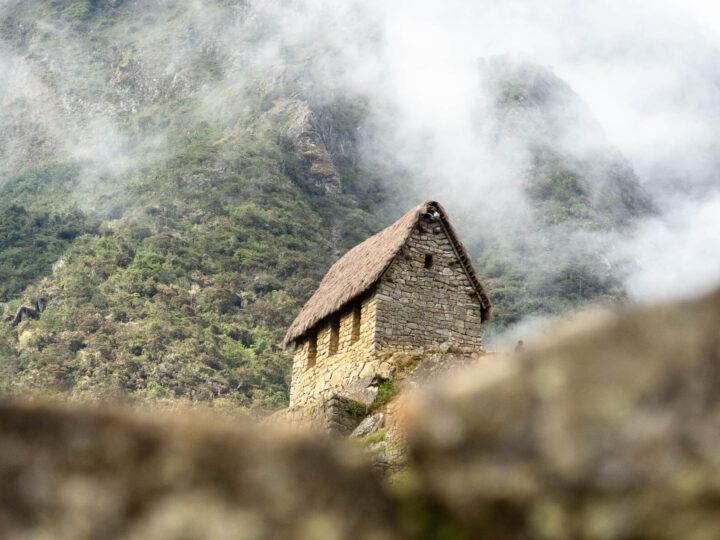
But to understand when are the best weather conditions for Machu Picchu, you must first understand the weather in Peru. While Lima may see only sunny days for weeks, Aguas Calientes – the closest town to Machu Picchu – may be inundated with rain. The weather varies considerably across Peru because of the terrain and ecosystems around this vast country and the impact of both the rainy and the dry seasons.
Machu Picchu weather by season
- December to March (rainy season)
At the Inca site, the average temperature ranges between 12 and 24°C (54-75°F). You can expect showers mostly in the afternoon. Though there is no certainty which months will experience the heaviest downpours, February has the highest precipitation level on average.
Due to safety reasons and for maintenance, the Inca trail is closed during February, while other treks (such as the Salkantay and the Lares) are at their wettest during this month. Trails in Machu Picchu itself can be dangerous during the rainy season, especially those leading up to Huayna Picchu Mountain.
Want a cheeky 5% discount on the Inca trail?
Alpaca Expeditions are not only one of the most sustainable companies offering Inca trail treks to Machu Picchu, but their guides, porters and chefs are the ultimate hosts.
They’re now offering Worldly Adventurer readers a 5% discount on all of their hikes – just mention Worldly Adventurer when you enquire!
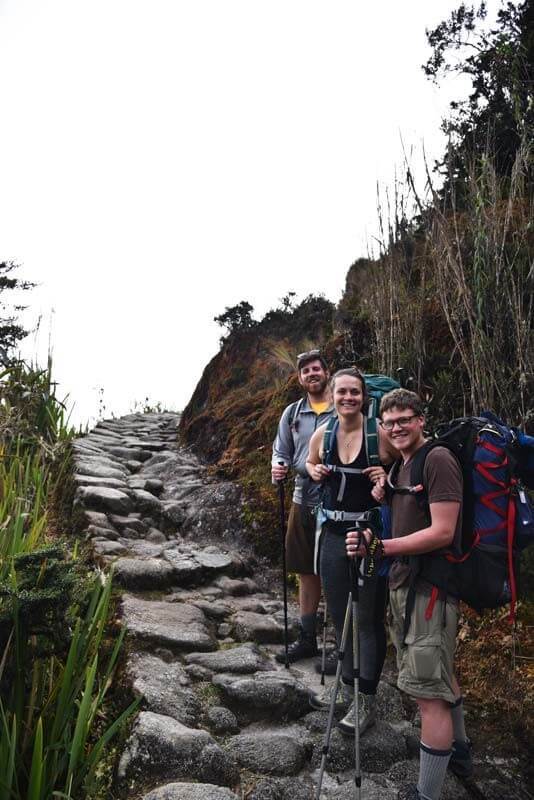
- May to September (dry season)
The average temperature ranges between 17 and 19°C (62-66°F), making these the coldest months at Machu Picchu. Unlike most tropical areas, Peru and, specifically, Machu Picchu is colder during the dry season, but you’re less likely to experience an overcast day.
As the precipitation of the rainy season has turned the landscapes lush green, the dry season offers the best views and the most photogenic conditions.
It is, for this reason, the peak season for tourism falls during July and August, which also coincides with summer vacations in the northern hemisphere.
- April, October, and November (shoulder season)
The rainy season ends in April, although rain showers are still likely during this month. It’s better to visit during the last month of dry weather (October) before the rainy season starts.
However, it’s worth remembering that even though the shoulder seasons are supposed to be dry, the weather remains a little unpredictable, with occasional downpours (but more sunshine!).
As a result, the best time of year to visit Machu Picchu according to the weather and the possibility of clear views of the archeological site is from June to July.
However, this settled, dry weather attracts the most crowds. Trekking to Machu Picchu – and most parts of the Andes mountains generally – is extremely popular during these months.
To learn more about the weather in Peru and when to visit, read our article about the best time to visit Peru .
Which months are better for avoiding crowds at Machu Picchu?
Though it’s open every day, Machu Picchu’s busyness should also influence when you choose to visit. Large crowds mean more queueing time at the entrance and more effort to get unobstructed views of the site itself.
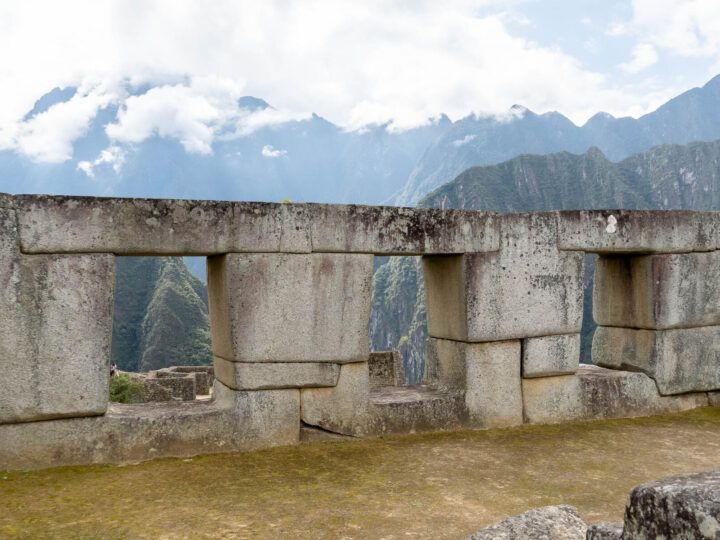
The low season – from December to March – means fewer crowds but possibly very wet weather conditions. That said, there may be one sunny day between weeks of rainy days, just like there may be a little rain during the dry season.
But it’s a big gamble since you cannot reschedule or refund your Machu Picchu tickets.
Here are the rough estimations of average daily visitors based on the number of tickets sold in 2018 , before the pandemic hit. August received the most visitors, with more than 4,800, and December was the least, with 1,900.
As you can see, even during low season, Machu Picchu still attracts many people. This should come as no surprise, considering it’s one of the things you must see in Peru’s Sacred Valley .
Daily average Machu Picchu tickets sold in 2018
- January ± 2,800 visitors per day
- February ± 2,400 visitors per day
- March ± 2,800 visitors per day
- April ± 3,200 visitors per day
- May ± 3,700 visitors per day
- June ± 3,600 visitors per day
- July ± 4,500 visitors per day
- August ± 4,800 visitors per day
- September ± 4,200 visitors per day
- October ± 4,000 visitors per day
- November ± 3,200 visitors per day
- December ± 1,900 visitors per day
So, when is the best time to visit Machu Picchu?
Considering weather conditions and crowds, the shoulder season is the ideal time for exploring the Inca citadel. The months of April, October, and November provide the opportunity to avoid the worst of the weather and the majority of other tourists.
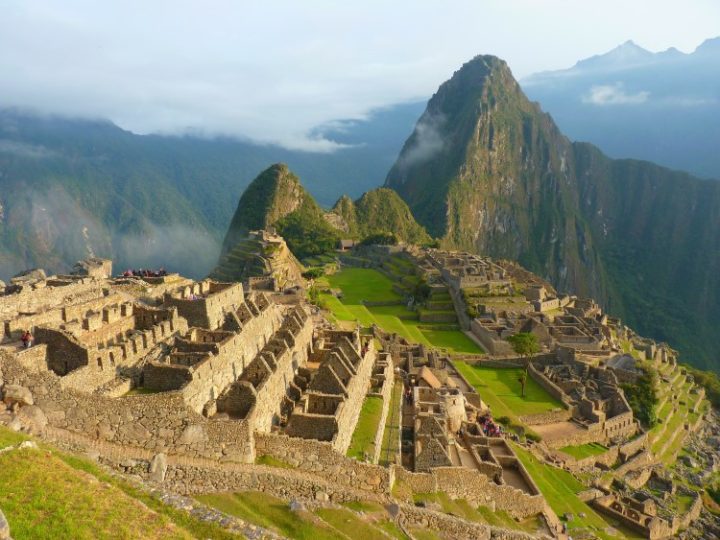
During these shoulder months, you’ll have quieter treks, as crowds are a fraction of what they are in high season. Keep in mind that even on sunny days, you can expect cold nights where the temperatures may drop below freezing.
Pack extra warm clothes and layers for your time hiking the Inca trail or the Salkantay and staying in Cusco and the wider Andes.
The best time of the year to visit is one thing, but choosing the best time of day is another. Among the nine available time slots, five are in the morning. Which of those is the one to choose?
The answer depends on how you plan on arriving: on a train from Ollantaytambo or Cusco or on foot through the hiking trails. Those interested in the former should check our recommendations about the best hotels in the Sacred Valley and, if you’re a fan of the ultimate comfort, the best luxury hotels across Peru .
If you’re taking the train to Machu Picchu
Even in low season, you’ll still be among hundreds (or even thousands) of people visiting the Inca citadel. So there may still be long lines, especially when waiting for the bus to and from the site. The most popular time is early morning, especially between 8 to 11 am.
So, if you want to avoid the busiest time, opt to go in the afternoon (12 to 1 pm, 1 to 2 pm, or 2 to 3 pm time slots).
Alternatively, you can also try to be the first one to arrive before the gate opens for the first time slot (6 to 7 am). Beat the crowds by getting on the earliest bus to Machu Picchu from Aguas Calientes; this departs at 5:30 am from Avenida Hermanos Ayar , right by the river.
Going that early in the morning means spending at least one night in Aguas Calientes (Machu Picchu pueblo) itself.
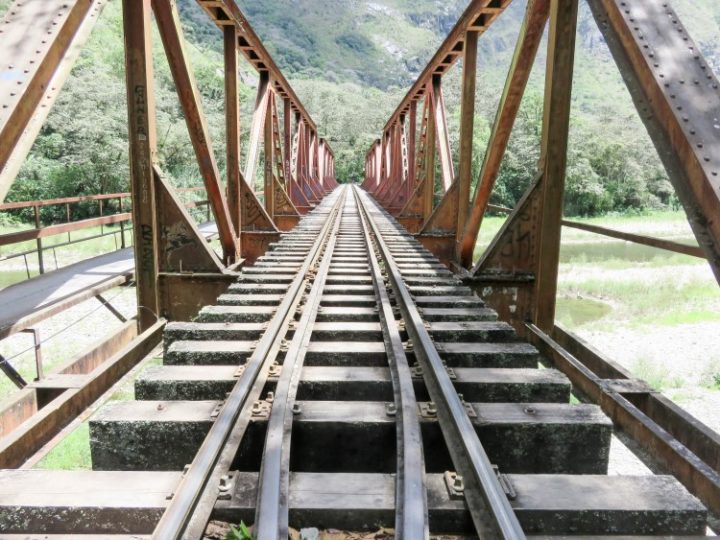
I booked my bus ticket weeks before my visit to secure my seat on that first bus. I noticed those who purchased theirs on-site had to wait for the following bus, even if they’d probably aimed for the first bus. Therefore, it’s best to book your bus tickets in advance (you can do it here ).
Another way to ensure you’ll be the first in line when the gates to Machu Picchu open is to hike from Aguas Calientes instead of taking the bus. The catch is that you will need to start early, as the hike may take around one to two hours, depending on your fitness level – and it’s all uphill.
Insider tip: You can also use these tips during the busiest months to minimize the queues – although be aware that many visitors will try to do the same. Even if you ride the earliest bus, those who hike from Aguas Calientes may get there before you.
For those hiking the Inca trail
The most adventurous trek is the Inca Trail to reach Machu Picchu . Not only is it an excellent challenge, but allows you to relive the pilgrimages undertaken by the Inca themselves.
While the Inca built many trails throughout the Peruvian Andes, the route to Machu Picchu is a part of the Qhapaq Ñan (“Royal Road”) used exclusively by Inca royalty and pilgrims.
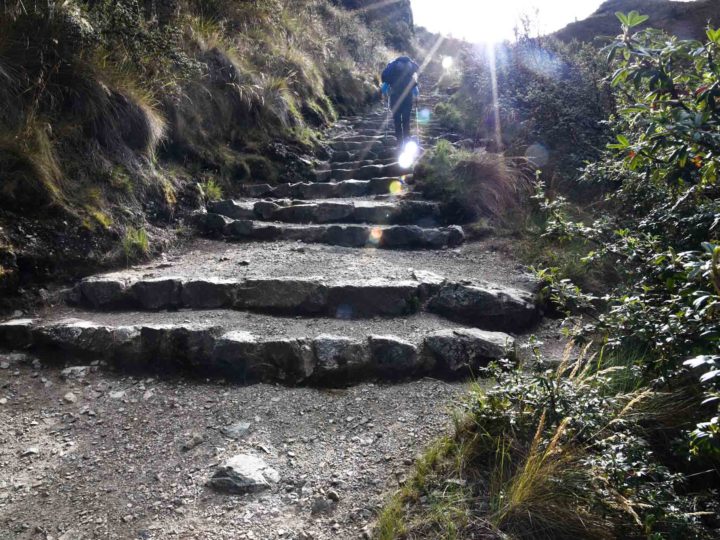
Regardless of when you trek, the end of this four-day hike is the arrival at the Sun Gate in Machu Picchu, with most reaching here at 6am to see the sunrise. If you’re a slower hiker, you may struggle to do this, however.
If you’re still keen to avoid large crowds, visiting during low or shoulder season will give you a better chance of achieving this.
Much like your ticket to Machu Picchu, your Inca trail permits must be purchased months in advance. I highly recommend trekking with the locally-owned company Alpaca Expeditions . They were brilliant when I visited Machu Picchu and they also work really hard to support indigenous communities across Cusco.

Best Time To Visit Machu Picchu
Machu Picchu is one of the most popular attractions in South America. This UNESCO World Heritage Site attracts more than 2 million visitors each year, and for good reason. It is a spectacular place with a fascinating history, beautiful scenery and many activities.
With so many people visiting Machu Picchu each year, it is important to know the best time to visit Machu Picchu. Here are some tips for planning your trip:
The best months to visit Machu Picchu: May to October.
During this time, the weather is usually sunny with clear skies and temperatures range between 15 and 25 degrees Celsius (60-77 F). The rainy season lasts from October to March. During these months, there are frequent showers and thunderstorms that can last for hours. It is also possible to get snow in the higher mountains of Cusco during these months if you are lucky enough to visit the country in early January or late February.
So, in summary, let’s answer this question:
What is the best time to visit Machu Picchu?
The best time to visit the Inca citadel of Machu Picchu is during the dry season from April to October. For warmer temperatures with light to heavy rains, visit from November to March.
Keep in mind that Peru is a large country with diverse geographies, including beaches, desert, mountains and rainforest – each with its own climate, flora, fauna and climatic conditions.
This makes it difficult to determine a good time to travel to Peru if you are visiting several places during your trip.
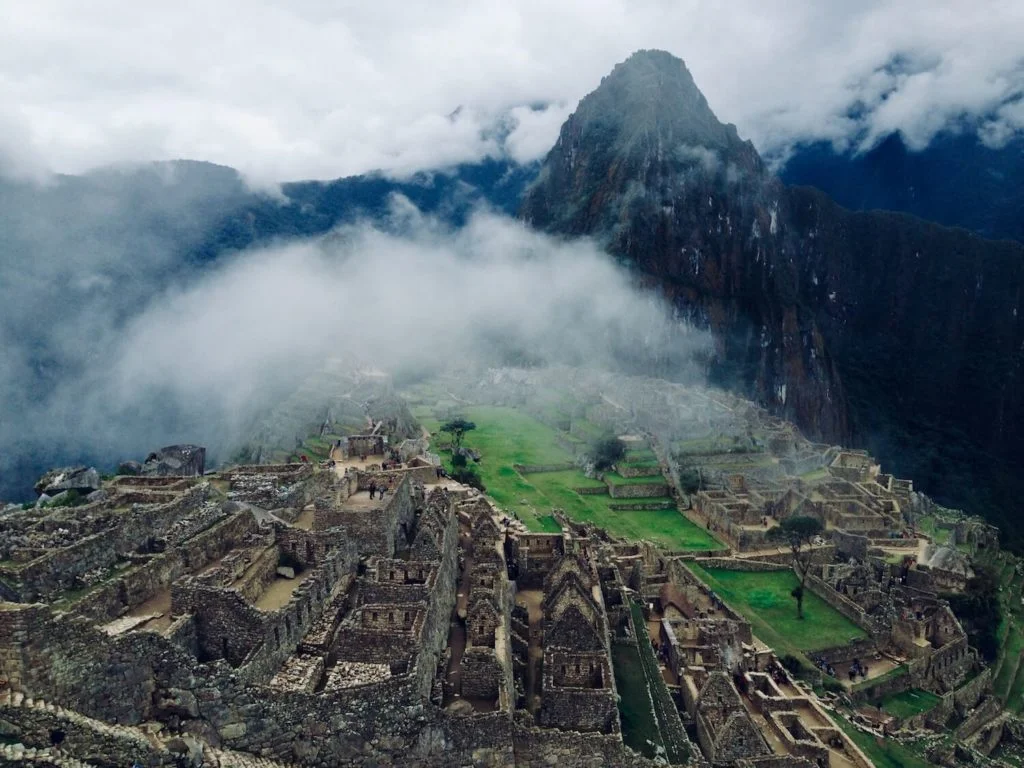
Our best advice is to check the weather conditions at each of your destinations – or ask your friendly Travel Advisor for some advice! – and pack your things accordingly.
Machu Picchu is open 7 days a week, every day of the year, including holidays.
Best time to go
If you want the chance to see one of the Seven Wonders of the World as seen in the classic photographs – clear blue skies as a backdrop of sunlit stone ruins nestled amidst granite peaks covered by the jungle.
Your best chance during the dry season between May and October. Keep in mind, however, that even during the dry season, there can be mornings and evenings with strong mists that can obscure the views.
Rear our blog: How to get to Machu Picchu .
The warmest climate
For a tour to Machu Picchu, the warmest weather is from November to March. But this also corresponds to the rainy season. In other words, higher temperatures do not correlate with good weather in Machu Picchu.
The peak season is from June to August.
The peak travel season for tourists from all over the world and from all over Peru who arrive in Machu Picchu is from June to August. During this time, large crowds can make it a bit difficult to move around some parts of the Sanctuary and long queues at the entrance to the ruins are common.
June through August is also a popular time for travelers who choose the most difficult and exciting way to get to Machu Picchu by the Inca Trail.
The rainy season
Rain from light drizzles to heavy rains occurs almost every day from November to March. The strongest rain is in February, which is also when the Inca Trail trail is closed for maintenance.
The flowering season begins in October/November and continues until March.
The dry season
In general, we believe that the best time to visit Machu Picchu is from April to October. Again, rain and fog is possible at any time of year because Machu Picchu is located on the edge of the rainforest. But during the “dry season”, you have the best chance of appreciating all the beauty of the ruins.
Machu Picchu Weather By Month
Machu picchu in january.
The climate in Machu Picchu in January and in the Andean mountains of Cusco is rainy. Historically it has been a month of mudslides on the Inca Trail to Machu Picchu. Rain may not be advisable for hiking, but you can still go by train.
Note: The trails leading to the Huayna Picchu and Machu Picchu mountains are considerably slippery. There is always a risk of rocks falling, and the chances of enjoying the fabulous views are minimal.
Temperatures at Machu Picchu in January are warm and range from 27˚C/80˚F during the day to 17˚C/63˚F at night.
Read more: Machu Picchu in January .
Machu Picchu In February
Machu Picchu’s weather in February makes this month the worst time of year to go to Machu Picchu. The rains during this month are unbearable, particularly in places like the cloud forest where Machu Picchu is located. The risks of getting stuck in Aguas Calientes due to landslides that bury the train tracks or the Urubamba River flooding are a constant threat.
Machu Picchu National Sanctuary closes the Inca Trail during the month of February to carry out a clean-up campaign along the trail, replacing bridges and reconditioning camps and bathrooms. Torrential rains also bring thick clouds that block the views. Trails, bridges and stairs become muddy and slippery. Things become a bit dangerous, especially when one plans to climb the mountains of Machu Picchu or Huayna Picchu.
Temperatures at Machu Picchu in February range from 28˚C/82˚F during the day to 18˚C/65˚F at night.
Read more: Machu Picchu in February .
Machu Picchu In March
We recommend that you book your route during the last two weeks of March. With the decrease in rainfall, the climate of Machu Picchu in March improves a lot. The beautiful views are resurfacing offering tourists the best photo operations in the Andean mountains.
Temperatures at Machu Picchu in March range from 27˚C/81˚F during the day to 17˚C/64˚F at night.
Machu Picchu In April
The combination of a warmer climate, fewer crowds and magnificent views makes April one of the best months of the year to visit this Inca city. Machu Picchu’s climate in April makes it ideal for the Inca Trail or alternative hikes.
Temperatures at Machu Picchu in April range from 22˚C/77˚F during the day to 14˚C/61˚F at night.
Read more: Machu Picchu in April .
Machu Picchu In May
Machu Picchu’s weather in May marks the arrival of the dry season, the blue skies and the impressive views of the snow-capped mountains of the Andes. It also marks the attack of tourists with long lines at the bus station. We recommend alternative hikes such as Huchuy Qosqo, the short Inca Trail or the Salkantay to avoid the crowds.
Visiting Cusco and Machu Picchu in May is equally rewarding due to the many traditional Andean religious festivals held during the month. The Qoilloritti pilgrimage and the Corpus Christi celebrations are the two events to see.
Temperatures in Machu Picchu in May can be high 20˚s/70˚s requiring you to wear extra layers such as long sleeves, sun hats and lots of sunscreen. Be careful, because at night temperatures drop to 13˚C/55˚F requiring thicker layers of clothing.
Read more: Machu Picchu in May .
Machu Picchu In June
It’s the beginning of the high season for tourism. Expect to find thousands of people flooding into the city when the Winter Solstice celebrations begin. June is also the month of Cusco’s Anniversary. Festivals, parades and dancers take to the streets. The most important event is the Inti Raimi Festival, where the people of Cusco gather to recreate an ancient Inca religious festival.
With the arrival of winter, you can begin to feel the drop in temperature on Machu Picchu and the Inca Trail; especially before sunrise and after sunset.
Average temperatures range from 20°C/58°F to 11°C/52°F. Freezing temperatures of -5°C/23°F are expected during the nights and early mornings.
Despite the cooler climate, the views of the mountains and valleys during the day are impressive, as are the magnificent views of the Milky Way at night.
Read more: Machu Picchu in June .
Machu Picchu In July
Winter is in full swing in July. The skies are blue, and the views of the landscape, mountains and stars are breathtaking.
Temperatures at Machu Picchu during July are cold, ranging from 19°C/66°F during the day to 10°C/50°F at night. Temperatures during the nights and early mornings are below freezing. In contrast, daytime temperatures are high 70˚s, and sunlight is intense. Be careful and use plenty of sunscreen and a sun hat.
Please be advised: In July, almost all the tourist attractions are overcrowded, including Machu Picchu. The lines to get to Machu Picchu are long. Train schedules are busy, and prices go up for some services. Be prepared for more people than usual if you decide to go to Machu Picchu during the Peruvian holidays: July 27 and 28 (Peru’s independence day).
Read more: Machu Picchu in July .
Machu Picchu In August
As we are in the middle of winter, the weather in Machu Picchu in August is quite cold. We recommend that you come prepared with the appropriate winter equipment.
Crowds are not being left out as many people from the northern hemisphere are on summer vacation. Expect long lines and crowded trails. To avoid the crowds, we suggest climbing Machu Picchu. The views are magnificent at this time of year. We also recommend the Salkantay Trek – you won’t regret it!
The temperature of the Inca Trail and Machu Picchu in August is cold and ranges from 20°C/68°F during the day to 12°C/54°F at night. Temperatures during the nights and early mornings are below freezing. In contrast, daytime temperatures are high 70˚s, and sunlight is intense. Please wear sunscreen and a sun hat.
Read more: Machu Picchu in August .
SPRINGTIME IN PERU The buffer months are the best months of the year to visit Machu Picchu. The climate is pleasant, and there are fewer crowds for the most part.
Machu Picchu In September
September is the end of the dry season and the beginning of the rainy season. The first rains of September can surprise you at any time, so be prepared with rain gear. The views, for the most part, are beautiful and so are the pictures of the mountains and valleys. With a drastic decrease in visitors, this month is a quieter and more peaceful month.
Temperatures in Machu Picchu in September start to warm up again. They oscillate between 21˚C/70F during the day and 12˚C/54˚F at night.
Read more: Machu Picchu in September .

Machu Picchu In October
With far fewer crowds walking the trails and climbing the mountains, October is considered one of the best months to visit Machu Picchu. One can perceive the silence and solitude in many places of the Sanctuary.
The temperatures at Machu Picchu in October are the ideal climate for hikes ranging from 22˚C/72˚F during the day to 12˚C/54˚F at night.
If you are here during this time, we recommend that you climb the Huayna Picchu mountain – with a little luck; you will have good weather and great views!
Read more: Machu Picchu in October .
Machu Picchu In November
The weather in November marks the beginning of the rainy season, but it hardly rains, except for a few scattered showers. The flow of tourists continues to decrease, and if you prefer fewer people, then this is your month. And the views of the mountains are exceptional.
Temperatures at Machu Picchu in November range from 24˚C/75˚F during the day to 13˚C/54˚F at night.
As in October, if you are here at this time, we recommend you climb the Huayna Picchu mountain, with a bit of luck; you will have good weather and great views!
Read more: Machu Picchu in November .
Machu Picchu In December
The weather in December is touched by the approaching rain clouds, but there are some sunny days during the month. Fewer people visit Cusco for the Machu Picchu trek, most come to spend their holidays in this Inca city. Many Peruvians and tourists flood the city during Christmas and New Year.
Temperatures at Machu Picchu and the Inca Trail in December range from 26˚C/79˚F during the day to 16˚C/61˚F at night.
Read more: Machu Picchu in December .
The months with more availability of tickets to visit Machu Picchu.
If you want to avoid crowds during your trip and make the most of your Machu Picchu experience without being rushed by other tourists, then consider visiting between October and March . This way you will avoid the high season, when thousands of tourists descend on the Inca ruins every day.
Read our detailed section of Machu Picchu Tickets .
Dry season, June, July, August and October.
the busiest months are: June, July and August are by far the busiest months for visiting the New Wonder of the World. Winter in the Andes is the busiest time of year with thousands of people coming from the United States, Canada and other European countries during their summer vacation
The answer is at 6:00 am or any time after 3:00 pm. Get on one of the first buses that leave the city of Aguas Calientes at 530 am so you can see the sunrise in Machu or get there once 80% of the people have left after 3:00 pm. The views of the sunset are impressive and quite underrated.
Read This Next
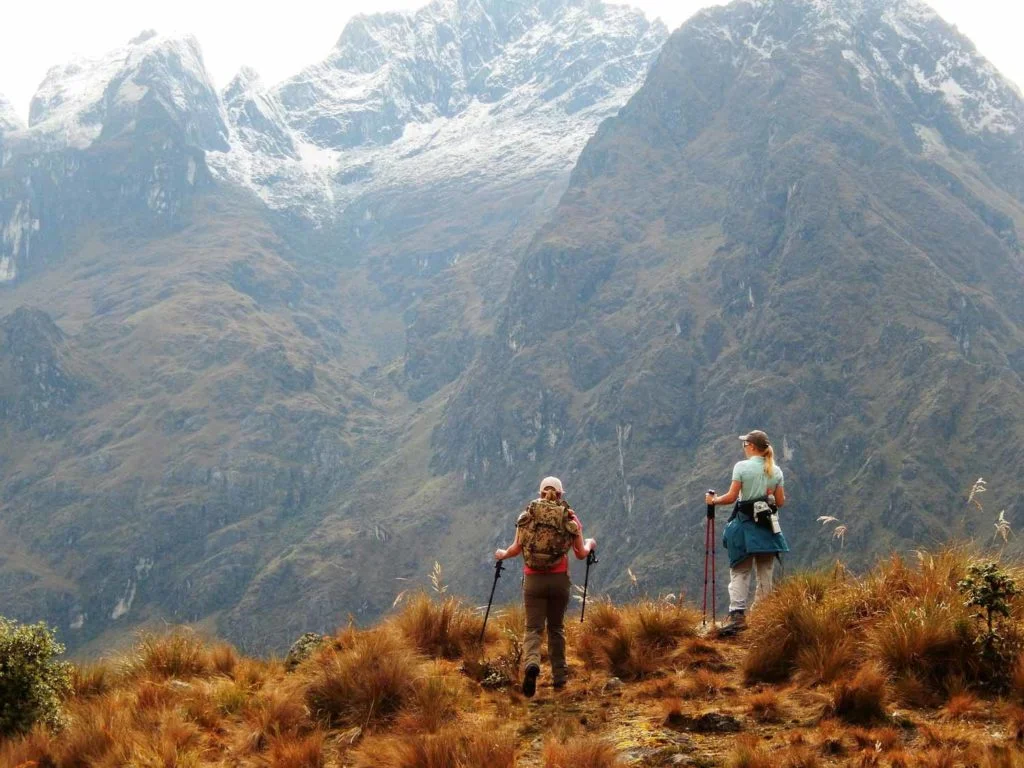
Best Time To Hike Inca Trail To Machu Picchu
Machu picchu 7th wonder of the world, how to get to machu picchu, leave a comment cancel reply.
Your email address will not be published. Required fields are marked *
Best time to visit Machu Picchu Peru + When to avoid 2023
Disclaimer: This post contains affiliate links. At no cost to you, I might earn a small commission if you make a purchase through the links in this article.
Thinking of visiting the mysterious remote mountainous ruins of Machu Picchu? For many, visiting these ruins deep in the Peruvian jungle is a once-in-a-lifetime journey. Make sure you plan for the best time to visit Machu Picchu to make the most of this historic site.
Located at more than 2,400 meters above sea level (more than 7,800 feet) Machu Picchu is a UNESCO World Heritage site and one of the New Seven Wonders of the World. Machu Picchu was built by the Incas and showcases their skill in building on this complex site.
✔️ Spending a couple of days in the Peruvian capital? Check my guide to Uber in Lima to find out how to get around the city.
Called the “Lost City of the Incas” experts are unclear about why Machu Picchu was built (around 1420), and why it was abandoned approximately 100 years later. Many believe it was a summer residence of the Incan rulers built by the famous emperor Pachacuti.
Others believe it was a sacred site, that was not visited very often. The mystery surrounding the site is the reason why many people find this mountaintop site so mesmerizing.
Is Machu Picchu open?
Yes, Machu Picchu is open for visitors! The site is open every day from 6 am throughout the year. Visitors are limited to a daily number for some popular hiking options, so plan to secure your desired date. The Classic Inca trail closes for maintenance in February.
You’ll need to pre-book tickets to the site, and for a way to reach the site- either a bus from the base town of Aguas Calientes, a tour from Cusco , or a longer trek along the Inca Trail.
✅ Read: Is Cusco safe ?
Machu Picchu travel restrictions
To visit Machu Picchu, you must first enter Peru . As of November 2022, there are no longer any restrictions or vaccine requirements to enter the country, specifically the Machu Picchu site.
As of 2023, masks are not required in Machu Picchu. Vaccine cards, negative tests, and health authorizations are no longer required either.
US citizens entering Peru do not need a visa and may stay in the country for up to 183 days. You must have a passport valid for at least six months upon entry.
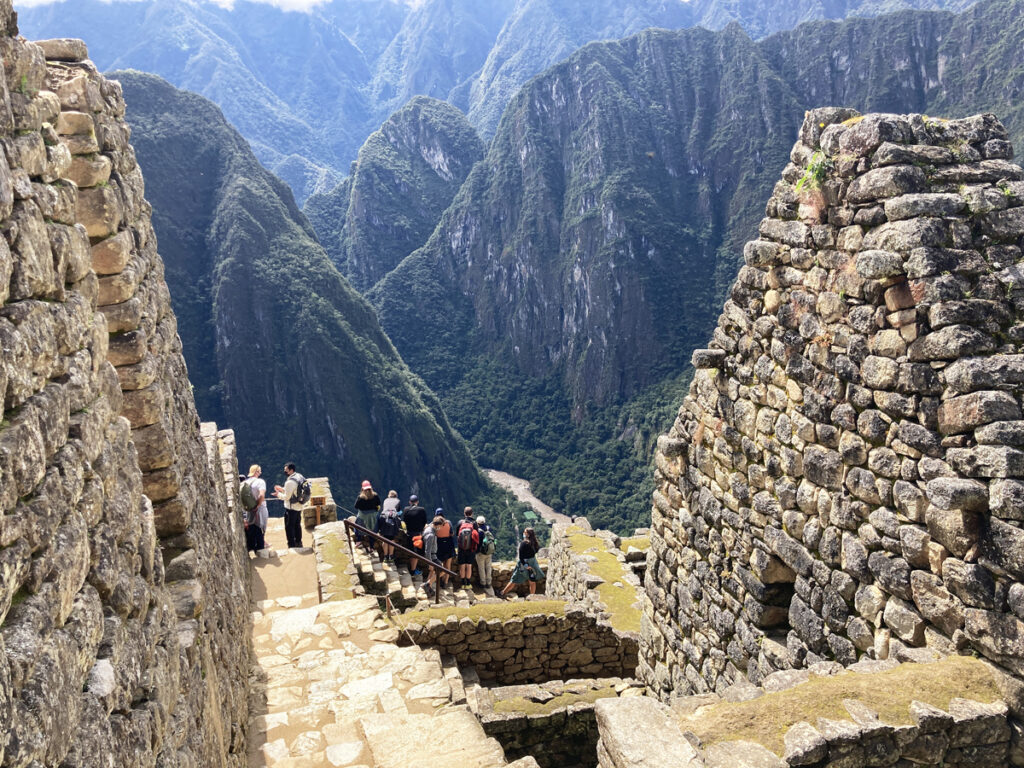
When is the best time to visit Machu Picchu?
The best time to visit Machu Picchu is in May and October when you’ll find the best weather, the least rain, and lower crowds than in the summer months.
✅ Read my complete guide to Rainbow Mountain – one of the most popular landmarks in Peru 😀
Machu Picchu weather by month
The weather in Machu Picchu is rainforest temperate- meaning that it’s very changeable! Even in the drier months, you should be prepared for sudden weather changes, from a cold wind to rain showers.
The high temperatures are stable throughout the year, making it a great year-round destination. During the winter months of July and August, the lows drop, resulting in chilly evenings.
Machu Picchu in November
November is the beginning of the rainy season in Machu Picchu – so you will find a mix of sunny days, and rainy days, with low crowd levels. The temperatures will still be warm during the day, reaching highs of around 78 degrees.
Bring extra layers and prepare for possible rain showers. Nights will be cool, so buddle up.
Machu Picchu in December – March
December through March in Machu Picchu is the rainy season. During this time, it rains almost every day, though often for only an hour or two. With this rain often comes cloudy skies which can interfere with the views at Machu Picchu. If you visit from December to March, try to get to the site as early as possible, as the mornings tend to be the clearest time of day.
Machu Picchu in April – June
From April through June, the rain will have largely stopped, and the weather will be warm, making this one of the best times to visit Machu Picchu.
During June, there are many festivals and parades in Cusco , and the crowds start to pick up. It’s an exciting time to visit which incorporates the buzz of the more popular hiking season without the highest crowds.
Machu Picchu in July and August
In July and August, Machu Picchu experiences its lowest temperatures, often dropping to around 45-48 degrees at night. The daytime temperatures stay steady at about 75-77 degrees Fahrenheit, so it’s still pleasant weather for hiking and exploring.
This combination of cool winter temperatures and the summer holidays in the Northern Hemisphere also brings on the highest crowds of the year.
Machu Picchu in September – October
September and October are fantastic months to visit Machu Picchu. You’ll find longer sunlight hours as the seasons change into Spring. The summer crowds will dissipate, and while you may have the occasional rain shower, you’ll still have mainly dry conditions for hiking and exploring.
When is the worst time to visit Machu Picchu?
Depending on your perspective, the worst time to visit Machu Picchu is either the crowded months of July and August or the rainy months between December and February.
Queuing in line to move forward in the site may be a horrible scenario to some, while others are more bothered by the rain, mud, and cloudy views!
What is the rainy season in Machu Picchu?
The rainy season in Machu Picchu runs from December to March. During this time, it tends to rain the heaviest in the afternoons. You can still visit Machu Picchu and will find the crowds are slim. However, part of the magic of Machu Picchu is the views, and you may find them obscured by fog and clouds.
What is the busiest month in Machu Picchu?
The busiest month at Machu Picchu is July, with August just behind, because many families choose to visit from the Northern Hemisphere while on summer break. From Thanksgiving to the end of November, the December holidays are also quite busy.
Machu Picchu from Lima
Coming from Lima, you will need to fly to Cusco, and take the train to Aguas Calientes, or join a tour leaving from Cusco. The flight from Lima to Cusco is about 1 ½ hours, with several flights leaving each day.
Beware that once you land in Cusco you will be at over 11,000 feet altitude. It is advisable to immediately head to Ollantaytambo or another town in the Sacred Valley to acclimate to the altitude and avoid high-altitude sickness.
Machu Picchu from Cusco
To head to Machu Picchu from Cusco, you can either go on your own via the base town of Aguas Calientes or take a guided tour that leaves from Cusco.
To get to Aguas Calientes, you will need to take the train or a bus to Ollantaytambo, and then a train from there- both IncaRail and PeruRail offer these services. The train is the preferred option, where you’ll have both basic and luxury options.
Some trains offer viewing areas with glass that extends to the ceiling, and even serve meals, while the more basic services include just a train seat.
From Aguas Calientes, you can hike up to the site, though this is not recommended. The hike is quite steep, and you will find better views at the site itself. The bus ride is approx. 30 minutes, and does switchbacks along the mountain as it climbs. You will pass through wet jungle-like terrain, with lots of small waterfalls beside the road.
Expect a long line to board the bus. Since you will have a timed entrance ticket for Machu Picchu, plan in extra time for boarding the bus so you will still arrive during your ticket window. Buses leave every 5-10 minutes, so the line moves quickly.
Tickets to Machu Picchu: Understanding the Options
When you choose your entrance ticket to Machu Picchu, you will have several options to choose from. If you are not choosing a tour that provides your tickets, you can purchase them online from the government website .
- Machu Picchu Ticket : Entry to the site of Machu Picchu, you can choose circuits 1, 2, 3, or 4 when you arrive and start your visit. You can see detailed maps of each circuit to plan your time.
- Machu Picchu Ticket + Wayna Picchu Mountain : This is the most popular combination, and sells out the fastest. The hike up Wayna Picchu Mountain is the steepest and most difficult, you’ll use your hands and cables for balance at times. It generally takes about one hour to climb. This trek is also sometimes called Huayna Picchu.
- Machu Picchu Ticket + Machu Picchu Mountain : The hike up Machu Picchu Mountain has the greatest elevation gain and wonderful views. This is a more gradual climb via stone steps that is less crowded than Wayna Picchu.
- Machu Picchu Ticket + Huchuy Picchu Mountain: This is a recently added route that ascends to a lower peak on the way to Wayna Picchu. This hike is only 1 km long, so by far the easiest of the three popular options.
- Machu Picchu + Inca Bridge : In the past, you could hike to the Sun Gate (no longer allowed) or the Inca Bridge without a ticket. You now need to specify this short 20-minute hike when you buy your ticket.
Trekking to Machu Picchu
If you will be taking a trek into Machu Picchu or a guided tour, these will usually start from Cusco. Treks to Machu Picchu are moderately difficult. Most treks head up and over before descending to Machu Picchu, which means steep trails and high altitudes.
Classic Inca Trail
The most popular hike to Machu Picchu is the Classic Inca Trail. This overland hike is quite difficult and takes 4 days to reach Machu Picchu. While there is no official age limit on the trail, due to the altitude and difficulty, it is not recommended for children under 12 years old.
Salkantay Trek
The Salkantay Trek is another popular hike to Machu Picchu. If you’re looking for a more intense adventure, this could be the trek for you! Lasting 5 days, this trek starts in Cusco and ends in Machu Picchu. It includes Humantay Lake and the Incachiriaska Pass, and involves trekking to an incredible elevation of over 15,000 feet!
Private Tours of Machu Picchu
Private tours are a great way to see Machu Picchu and take the stress out of planning. These tours include entrance and transportation tickets, as well as a guide to make sure you get the most out of your time at this UNESCO World Heritage Site.
Guided Tour of Machu Picchu
This tour begins in Aguas Calientes and includes your transportation and a tour guide for your time at Machu Picchu.
Two-Day Guided Tour to Machu Picchu
For a longer stay, we recommend this two-day tour that starts in Cusco, includes a free afternoon to explore the town of Aguas Calientes, and then a guided visit to Machu Picchu and your transportation back to Cusco at the end! A more laid-back way to see these amazing sites, without stressing over the logistics.
Machu Picchu and Rainbow Mountain 2-Day Tour
If you are short on time and want to check off two amazing sites in one- this is the tour for you! Visit the Instagrammable Rainbow Mountain on Day 1, then Machu Picchu on Day 2!
What do I need to know before going to Machu Picchu?
- Plan ahead – You will need to secure tickets to Machu Picchu several weeks to several months ahead of time. The popular hike to Huayna Picchu allocates 200 spaces a day and often sells out 3-4 months in advance.
- Tickets to Machu Picchu are timed – You need to arrive during your tickets specified time to gain entrance to the site, so plan your transportation accordingly.
- Bring your documents. You will need to show your ticket as well as your passport (or a digital copy of your passport at entry
- Use the bathroom at the entrance – The cost is 20 sols, and this is the only bathroom available. Once you enter the ruins there is no bathroom until you exit.
- You must choose a circuit to walk through the main ruins, you therefore cannot see everything, but will have to make choices as you walk. For example, if you take the high route on circuit 4, you will get great views over the site, and see alpaca below, but won’t get to stand near the animals. There is a guard placed that ensures that you do not “go backward” or cut across the routes.
- You do not need a guide to enter Machu Picchu though you can hire one when in line for the bus in Aguas Calientes, or outside the ticket window once you are at the Machu Picchu site.
- You do not need specialty hiking gear for Machu Picchu. Good hiking shoes are all that you need. While the Inca Trail can be quite challenging, the actual site of Machu Picchu is not that difficult and is suitable for all ages.
- Drones, selfie sticks, and tripods are not allowed inside the Machu Picchu site.
- Avoid visiting Machu Picchu on Sundays if possible, this is a popular time for people from Cusco and the local area to visit the site, making it potentially more crowded.
- If you are starting in Cusco, beware of the altitude. Located at over 11,000 feet, this place can give you altitude sickness. Make sure to acclimate at a lower altitude before spending much time in Cusco, or attempting any high-altitude hikes.
- If you’ll be spending time at other sites in the Sacred Valley, you’ll need a Boleto Turistico , a combined ticket that is good for either 2 or 10 consecutive days from purchase.
What is the average cost of a trip to Machu Picchu?
The cost of a trip to Machu Picchu varies dramatically by where you are traveling from. Assuming that you are starting in Cusco, the average cost for one adult is $200-250 before food or accommodations.
The ticket to enter Machu Picchu (Standard, site only), is approximately $40 in 2023. The cost of the train from Cusco to Aguas Calientes ranges based on the level of luxury you choose but starts at around $125 for the lower tier. The cost of the bus from Aguas Calientes to Machu Picchu is approx. $24 USD round trip. You can negotiate the services of a tour guide for your time at the site. People pay an average of $70 for a guide for their group.
Keep in mind that most travelers will need accommodation in Cusco and Aguas Calientes, as well as plane tickets to reach the Sacred Valley.
Inca Trail to Machu Picchu
The Inca Trail is one of the most popular ways to get to Machu Picchu. This trek takes you high into the mountains along Incan roads, to cross the Inca Bridge and reach the Sun Gate above Machu Picchu 4 days later.
The classic Inca Trail covers 43 km (26 miles) of often steep terrain, peaking at over 13,000 feet of elevation. The trail’s combination of steepness and altitude makes it a challenging and rewarding hike.
Drink plenty of water, and watch for signs of altitude sickness including dizziness, and loss of appetite. Bring insect repellent and lots of layers including a warm hat and gloves for chilly mornings.
Once you complete the trail, you’ll descend to the main part of the Machu Picchu site, known as the citadel. You’ll enter along with other tourists and follow a set circuit after storing your gear.
What is the Best Time to Hike the Inca Trail?
The best time to hike the Inca Trail is in the dry season, ideally in May or October when the days are warm, and the crowds are low. Avoid the rainy season from December to March, when the trail will be muddy and slippery, and temperatures at night are at their lowest.
How Much Does It Cost to Hike the Inca Trail?
To hike the full 4-day Inca Trail costs range from $700 to $1500 USD per person depending on the tour agency, the size of the hiking group, and the level of service they are providing.
Most mid-range tours include pick up from a hotel in the Sacred Valley, entrance fees to the trail and the Machu Picchu site, camping equipment including a two-person tent, porters to carry shared gear, and all meals on the trek. A return bus ticket to Aguas Calientes and the train and bus combo back to Cusco is also usually included. Trekkers can also hire a porter to carry their gear for an additional fee.
What Tours are Available to Hike the Inca Trail?
The classic Inca Trail hike takes 4 days to reach Machu Picchu, departing from Cusco.
There are also shorter, 2-day tours for those looking to get the experience of entering via the Sun Gate without such a long trek. Covering 16 km of the Inca trail, this tour departs from the Sacred Valley town of Ollantaytambo. After arriving at the Sun Gate, you’ll overnight in Aguas Calientes before taking the bus to the main Machu Picchu site for a guided tour the next day.
Best time to visit Machu Picchu: FAQ’s
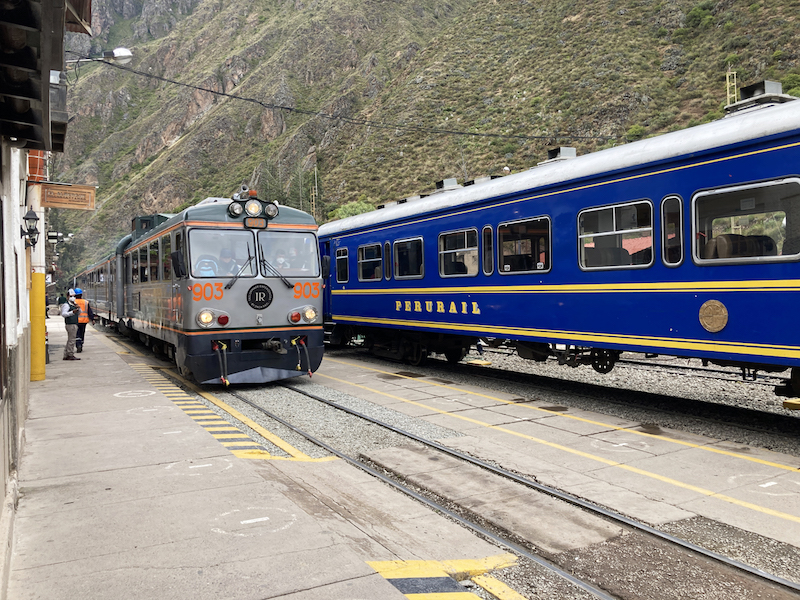
How many days do you need for Machu Picchu?
Once you arrive at the site of Machu Picchu, you only need one day to explore the site. As you enter, you will choose one of 4 circuits to see the site, as well as any other hikes like Huayna Picchu that you chose when purchasing your ticket.
If you are only visiting the site itself, you are only allowed two hours on the site. You cannot go backward along a circuit, or change circuits as you go.
If you count travel time to get to Machu Picchu, you will need 2-5 days to reach the site, either trekking over the mountains to Machu Picchu over the Inca Trail or arriving in Aguas Calientes the day before you visit Machu Picchu so you can get an early start at the site.
Can you do Machu Picchu in a day?
Yes, if you are not hiking into Machu Picchu, you can easily visit the site in one day. If fact, Machu Picchu makes a great day trip from Cusco .
The circuit you choose around the main site will take you approximately two hours, plus the time for Huayna Picchu or the mountain or Inca Bridge trail if you chose these options when selecting your entry ticket.
What is the least busy month to visit Machu Picchu?
The least busy time to visit Machu Picchu is January and February. However, these months are during the rainy season, so be prepared with rain gear. You will encounter mud and possibly cloudy conditions. Also, during February, the Classic Inca trail into Machu Picchu is closed for maintenance.
How many days do you need in Machu Picchu and Cusco?
There are many things to do in Cusco and the surrounding Sacred Valley. You can easily spend 3-5 days in Cusco, and there will still be more to see. It gives you time to visit Machu Picchu and the base town of Aguas Calientes and the broader Sacred Valley with sites like Ollantaytambo and Pisac.
What is the coldest month in Machu Picchu?
The coldest months in Machu Picchu are June and July, where low temperatures often hover around 48 degrees. This is winter in Peru, and while the daytime highs don’t fluctuate much from month to month, the nights get much cooler than at other times of the year.
Best time to visit Machu Picchu: final thoughts
The best time to visit Machu Picchu is in April, May, September, or October. These months are in the dry season when crowds are low, and temperatures are pleasantly warm. This fantastic site offers something for everyone- multi-day hikes for adventure enthusiasts, and easy bus transportation to the site for families and less active visitors. Machu Picchu is a wonderful combination of scenic natural viewpoints, and a way to learn about ancient Incan culture.
Don’t miss this incredibe experience in South America !
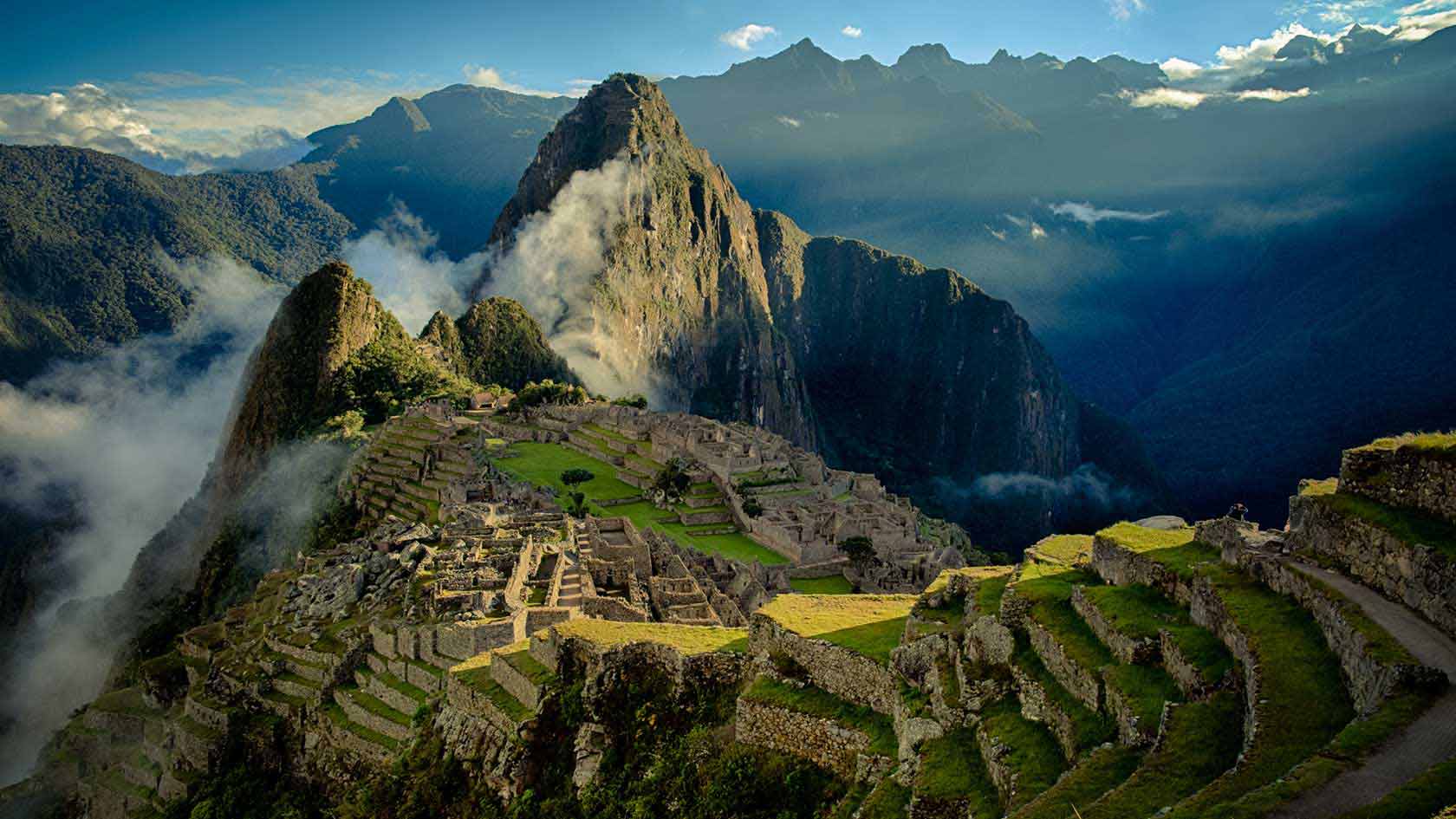
- BEST TIME TO VISIT MACHU PICCHU
WE CUSTOMIZE VIRTUALLY ALL SERVICES AVAILABLE IN PERU
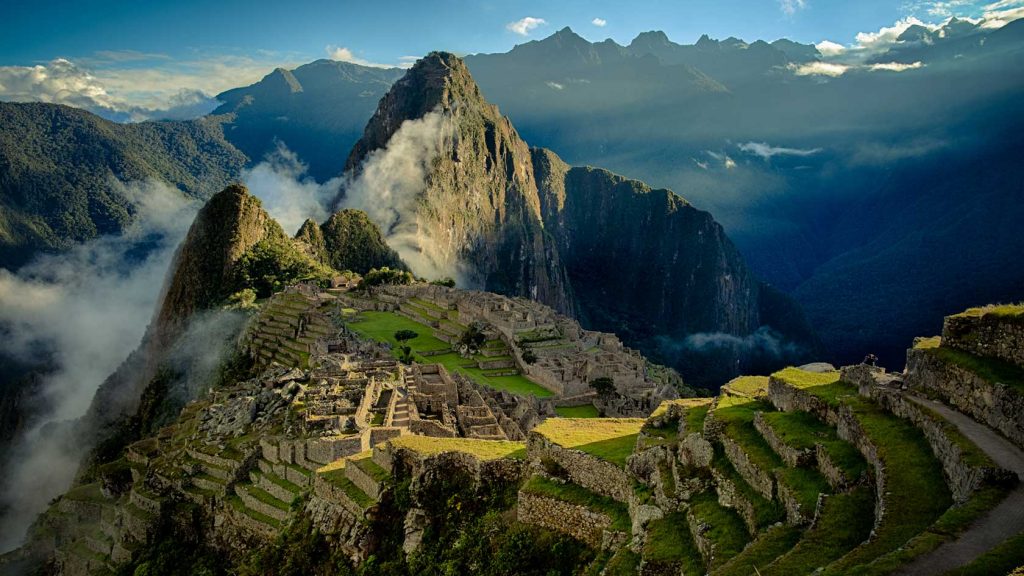
When is the best time to visit Machu Picchu ?
Machu Picchu is open 7 days a week, every day of the year, including holidays. The best season to visit Machu Picchu depends on your personal preferences and trip schedule. There’s a lot more to consider than just the weather forecast. Scroll down for more tips about:
Most Popular Time to Visit
Warm weather, peak season, dry season versus rainy season, inca trail to machu picchu.
- [Overview] Weather Conditions Throughout The Year
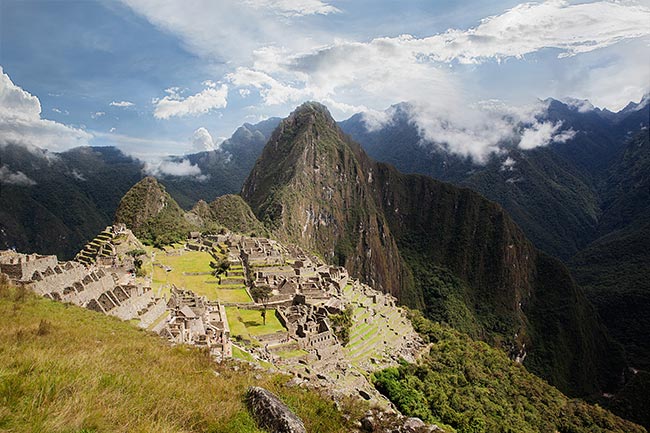
Higher temperatures do not correlate with the preferred sunshine and clear skies at Machu Picchu. Plan a tour to Machu Picchu between November and March for the warmest weather with daytime temperatures ranging between 68 to 80 Fahrenheit (20 to 27 Celcius). These months fall during the rainy season.
- Dry season is peak season at Machu Picchu. April to October see the most days with desirable sunshine but the trade off is more foot traffic around the site during your tour.
- Rainy season coincides with low season at Machu Picchu. Rain – anything from light drizzle to heavy downpours – occur almost daily from November until March. While this time of the year typically has the most rainfall, the upside is that Machu Picchu sees less visitors with the exception of Christmas and New Years. Last minute bookers enjoy a higher probability of reserving their desired hotel, transport, and trek options. Additionally, orchids love the rain — blooming season begins in October/November and continues until March.
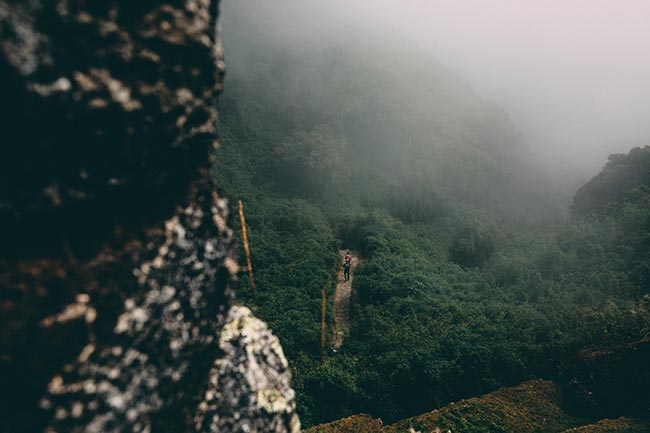
Weather Conditions Throughout the Year
- January, February & March – Rainy season. February typically sees the most rain.
- April & May – Shoulder season months between rainy and dry weather conditions. Overall pleasant climate and warm-to-cool temperatures.
- June, July & August – Dry season. Days are warm, the nights are cool.
- September, October & November – Shoulder season months between dry and rainy weather conditions. Overall pleasant climate and warm-to-cool temperatures.
In conclusion, there is never a bad time to visit Machu Picchu. The best time to visit Machu Picchu simply depends on your personal preferences and travel dates.
- PERU ITINERARIES
- CUSCO & MACHU PICCHU TOURS
- MACHU PICCHU TRAVEL INFORMATION
- THE TEMPLE OF THE SUN
Find out more Machu Picchu weather
- Machu Picchu Light Aventure
- Weather of Machu Picchu
Create Your Dream Adventure
Contact us for a comfortable and personalized itinerary to Peru
( Optional. You may choose more than one)
You also can write us at: [email protected]
Packages start at USD$1,239 for our 4-day Cusco & Machu Picchu package (with domestic flights included.) We specialize in complete travel packages that allow you to enjoy your travels while we handle the logistics. Services are available as part of a full itinerary (3-days or more) including all hotels, tours and ground transportation.
- Peru travel packages
- Travel information
- Things to do in Peru
- PERU DESTINATIONS
